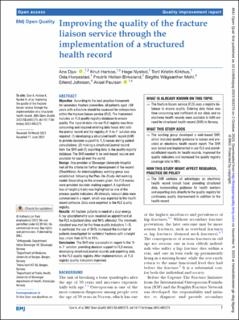| dc.contributor.author | Djuv, Ane | |
| dc.contributor.author | Harboe, Knut | |
| dc.contributor.author | Nysted, Hege | |
| dc.contributor.author | Kirkhus, Toril Kristin | |
| dc.contributor.author | Horpestad, Oda | |
| dc.contributor.author | Birkeland, Fredrik Holten | |
| dc.contributor.author | Mehl, Birgitte Wågsæther | |
| dc.contributor.author | Johnsen, Erlend | |
| dc.contributor.author | Paulsen, Aksel | |
| dc.date.accessioned | 2023-11-22T11:53:37Z | |
| dc.date.available | 2023-11-22T11:53:37Z | |
| dc.date.created | 2023-10-03T07:45:08Z | |
| dc.date.issued | 2023 | |
| dc.identifier.citation | Djuv, A., Harboe, K., Nysted, H., Kirkhus, T. K., Horpestad, O., Birkeland, F. H., ... & Paulsen, A. (2023). Improving the quality of the fracture liaison service through the implementation of a structured health record. BMJ Open Quality, 12(Suppl 2), e002275. | en_US |
| dc.identifier.issn | 2399-6641 | |
| dc.identifier.uri | https://hdl.handle.net/11250/3104106 | |
| dc.description.abstract | Objective
According to the best practice framework for secondary fracture prevention, all patients aged ≥50 years with a fracture should be assessed for osteoporosis within the fracture liaison service (FLS). The framework includes an FLS quality registry database to ensure quality. The input of data into our FLS registry was time-consuming and required entering data twice: into both the journal record and the registry. A ‘3-in-1’ solution was required: (1) developing a structured health record (SHR) to provide decision-support to FLS nurses during patient consultations; (2) making a structured journal record from the SHR and (3) exporting data to the quality registry database. The SHR needed to be web based, secure and available for use all over the world.
Design
One provider at Stavanger University Hospital met all the criteria for further development of the record (CheckWare). An interdisciplinary working group was established, following the Plan–Do–Study–Act working model. Depending on the answers given, the FLS nurses were provided decision-making support. A significant loss of height (≥4 cm) was highlighted as one of the process quality indicators. All clinically relevant data were summarised in a report, which was exported to the health record software. Data were exported to the FLS quality registry.
Results
All fracture patients in need of a dual-energy X-ray absorptiometry scan received an appointment at the FLS outpatient clinic and 96% attended. The minimum standard was met for the three quality indicators 1–3). In particular, the use of SHRs increased the number of patients investigated for vertebral fractures with a height loss ≥4 cm from 67% to 93%.
Conclusion
The SHR was successful in regard to the ‘3-in-1’ solution: providing decision support to FLS nurses, developing structured journal records and exporting data to the FLS quality registry. After implementation, all FLS registry quality indicators improved. | en_US |
| dc.language.iso | eng | en_US |
| dc.publisher | BMJ Publishing Group Limited | en_US |
| dc.rights | Navngivelse-Ikkekommersiell 4.0 Internasjonal | * |
| dc.rights.uri | http://creativecommons.org/licenses/by-nc/4.0/deed.no | * |
| dc.title | Improving the quality of the fracture liaison service through the implementation of a structured health record | en_US |
| dc.type | Peer reviewed | en_US |
| dc.type | Journal article | en_US |
| dc.description.version | publishedVersion | en_US |
| dc.rights.holder | © The Authors | en_US |
| dc.subject.nsi | VDP::Medisinske Fag: 700::Helsefag: 800 | en_US |
| dc.source.volume | 12 | en_US |
| dc.source.journal | BMJ Open Quality | en_US |
| dc.source.issue | Suppl. 2 | en_US |
| dc.identifier.doi | 10.1136/bmjoq-2023-002275 | |
| dc.identifier.cristin | 2181145 | |
| dc.source.articlenumber | e002275 | en_US |
| cristin.ispublished | true | |
| cristin.fulltext | original | |
| cristin.qualitycode | 1 | |

